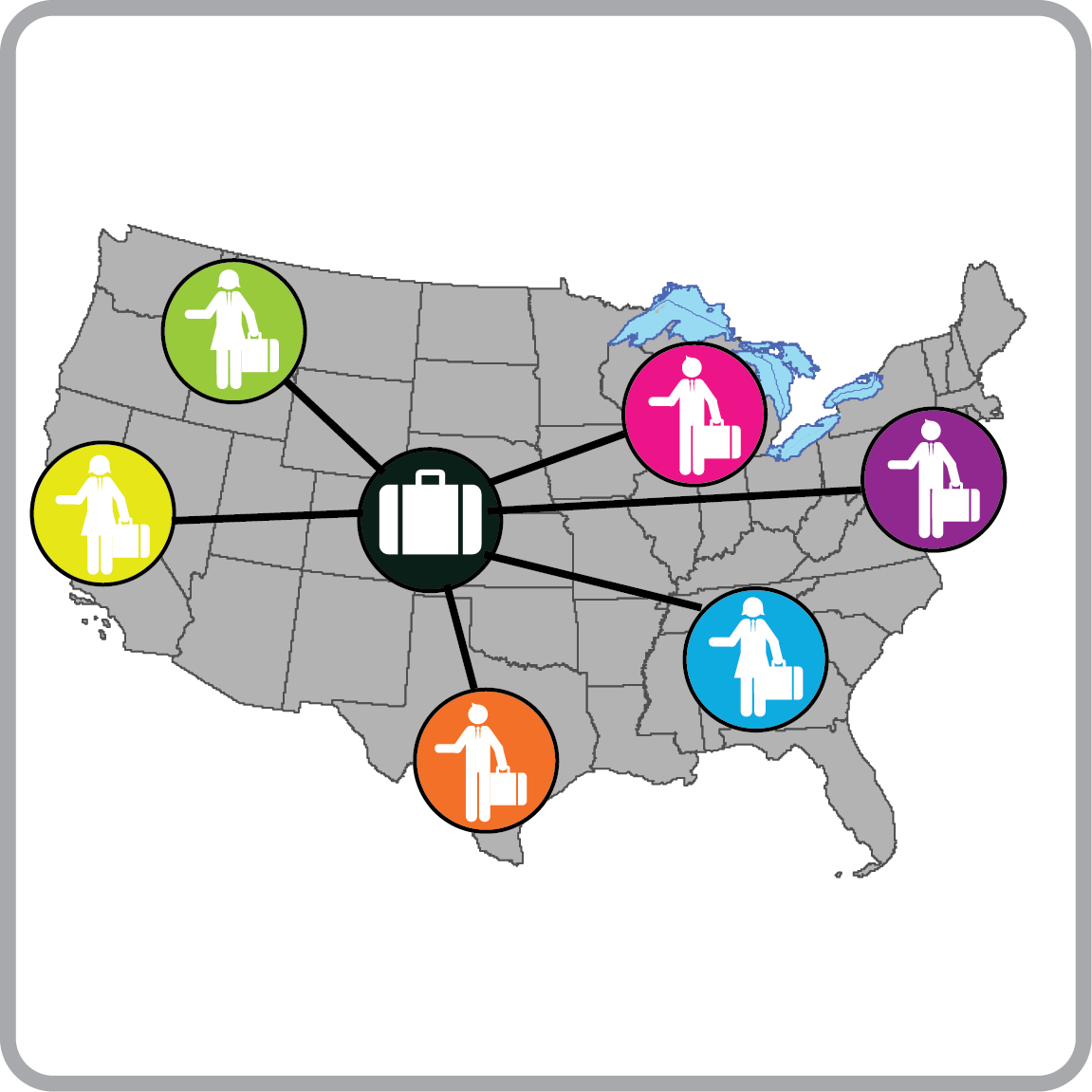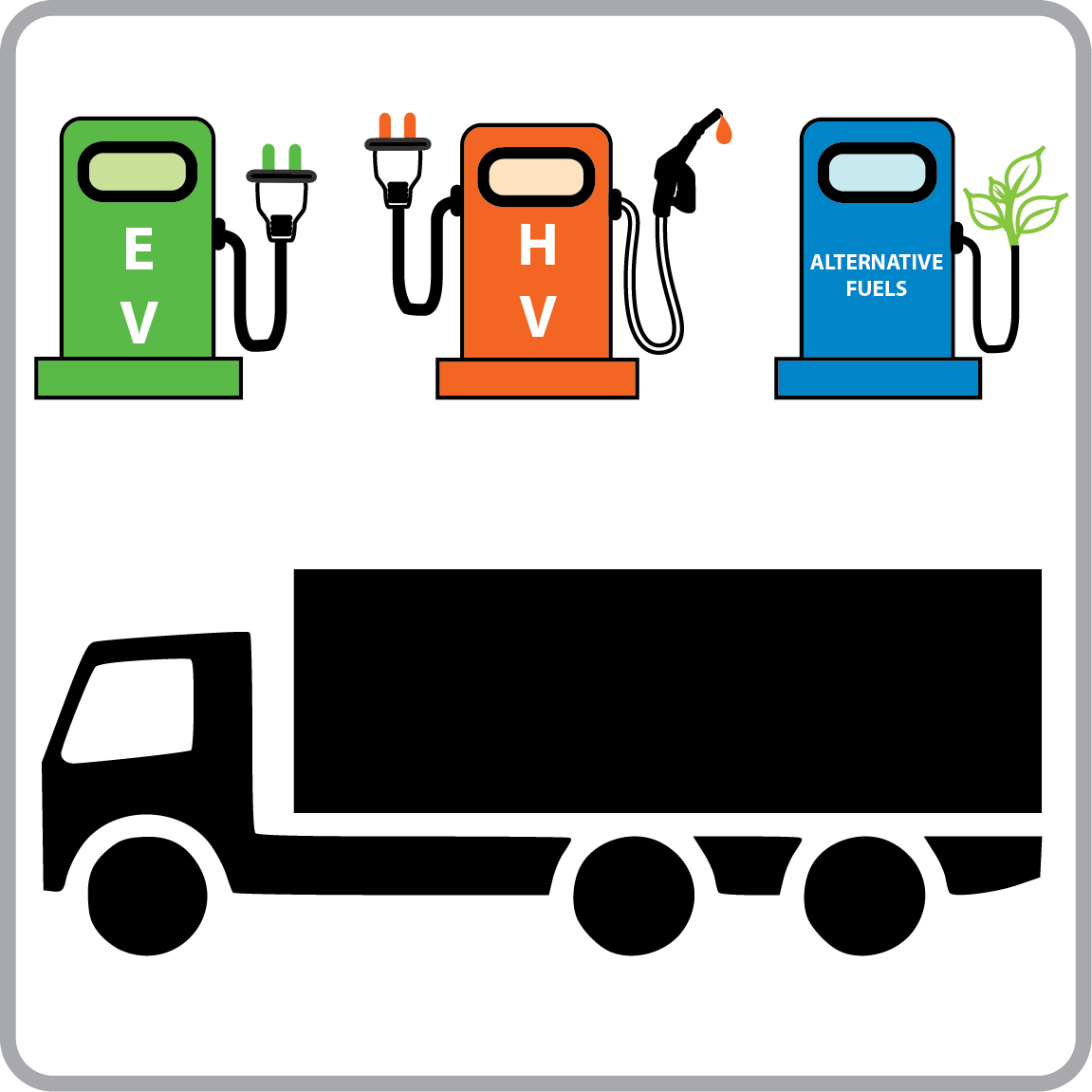|
|
I will drive this vehicle miles per year.
I can sell my current vehicle for $ and purchase a new one for $- Price of gasoline: $ per gallon

- Well-to-pump emissions: 20% of fossil fuel emissions. This includes emissions from the fuel used to find, extract, transport and refine crude oil into gasoline
- Greenhouse gas emissions from vehicles manufacturing: 53 grams CO2e per mile (8 metric tons per vehicle / 150,000 miles lifespan)
- Not included: emissions from road construction and maintenance, and other government-related emissions
|
|
 My company will trade in
, which gets 0
miles per gallon and buy a more efficient, alternative fuel vehicle that gets
miles per gallon.
My company will trade in
, which gets 0
miles per gallon and buy a more efficient, alternative fuel vehicle that gets
miles per gallon. Our employees will drive this vehicle miles per year. Alternative fuel will cost $/gal.
We can sell our current vehicle for $ and purchase a new one for $- Price of gasoline: $ 0 per gallon

- Well-to-pump emissions: 20% of fossil fuel emissions. This includes emissions from the fuel used to find, extract, transport and refine crude oil into gasoline
- Greenhouse gas emissions from vehicles manufacturing: 53 grams CO2e per mile (8 metric tons per vehicle / 150,000 miles lifespan)
- Alternative fuel: CNG
- A number of rebates are available for alternative fuel vehicles from state, federal and local agencies. We assume $2,000 rebate per vehicle is available at the time of purchase
- Not included: emissions from road construction and maintenance, and other government-related emissions
|
|
 My company will trade in
, which gets 0
miles per gallon and buy a more efficient, electric vehicle that gets
miles per gallon.
My company will trade in
, which gets 0
miles per gallon and buy a more efficient, electric vehicle that gets
miles per gallon. Our employees will drive this vehicle miles per year.
We can sell our current vehicle for $ and purchase a new one for $- Price of gasoline: $ 0 per gallon

- Greenhouse gas emissions from vehicles manufacturing: 53 grams CO2e per mile (8 metric tons per vehicle / 150,000 miles lifespan)
- Price of electricity: 0 (cents/kWh)

- A number of rebates are available for alternative fuel vehicles from state, federal and local agencies. We assume $2,000 rebate per vehicle is available at the time of purchase
- Not included: emissions from road construction and maintenance, and other government-related emissions
|
|
 My company will trade in
, which gets 0
miles per gallon and buy a more efficient, electric vehicle that gets
miles per gallon.
My company will trade in
, which gets 0
miles per gallon and buy a more efficient, electric vehicle that gets
miles per gallon. Our employees will drive this vehicle miles per year. We can sell our current vehicle for $ and purchase a new one for $
- Price of gasoline: $ 0 per gallon

- Well-to-pump emissions: 20% of fossil fuel emissions. This includes emissions from the fuel used to find, extract, transport and refine crude oil into gasoline
- Greenhouse gas emissions from vehicles manufacturing: 53 grams CO2e per mile (8 metric tons per vehicle / 150,000 miles lifespan)
- Price of electricity: 0 (cents/kWh)

- A number of rebates are available for alternative fuel vehicles from state, federal and local agencies. We assume $2,000 rebate per vehicle is available at the time of purchase
- Not included: emissions from road construction and maintenance, and other government-related emissions
|
|
 My employees typically drive to work in a
vehicle that gets
mpg.
I will encourage
employees to telecommute
days per week to work, which is on average a
mile trip each way.
I will reward employees who telecommute with a gift card worth $
per week.
My employees typically drive to work in a
vehicle that gets
mpg.
I will encourage
employees to telecommute
days per week to work, which is on average a
mile trip each way.
I will reward employees who telecommute with a gift card worth $
per week.
- Pounds CO2 per gallon: 19.4
- Well-to-pump emissions: 26%
- Price of gas per gallon $0
|
|
 I will encourage
employees to take
miles per week instead of driving.
The program will cost $
per participating employee each week.
I will encourage
employees to take
miles per week instead of driving.
The program will cost $
per participating employee each week. - Price of gasoline: $0 per gallon

- Carbon intensity of different transit options (gCO2e/passenger mile):
- Diesel bus , average occupancy of bus is 11 passengers
- Natural gas bus , average occupancy is 11 passengers
- Electric transit rail , average occupancy is 37 passengers per rail car
- Amtrak , average occupancy is 23 passengers per rail car
|
|
 My company vehicle fleet is currently driven a total of 0 miles per year, of which
% are highway miles.
The average fuel economy of my vehicles is 0 miles per gallon.
Reducing my top cruising highway speed from
mph to
mph will improve my fuel
economy by 1% per mph reduction over 60 mph. Reducing all rapid acceleration and braking can improve non-highway fuel economy by 3%.
Together these actions will improve my fuel economy to 0 miles per gallon,
saving 0 gallons per year.
My company vehicle fleet is currently driven a total of 0 miles per year, of which
% are highway miles.
The average fuel economy of my vehicles is 0 miles per gallon.
Reducing my top cruising highway speed from
mph to
mph will improve my fuel
economy by 1% per mph reduction over 60 mph. Reducing all rapid acceleration and braking can improve non-highway fuel economy by 3%.
Together these actions will improve my fuel economy to 0 miles per gallon,
saving 0 gallons per year.
- Price of gasoline:
$0 per gallon

- Average top cruising speed represents % of highway miles
|
|
 My employees on average drive a total of 0 miles per year, with an average fuel economy of
0 miles per gallon.
My employees on average drive a total of 0 miles per year, with an average fuel economy of
0 miles per gallon.
and
- Price of gasoline:
$0 per gallon

- Keeping tires inflated improves fuel efficiency by percent
- Changing air filters regularly improves fuel efficiency by percent
- Keeping tires inflated costs $
- Changing air filters regularly costs $
|
|
 My employees typically drive alone in a
that is
and gets
mpg.
We will encourage
employees to carpool
days per
to work, which is a
mile trip each way.
We will encourage our employees to carpool in a vehicle that gets
mpg
with a total of
people (including the driver).
We will reward employees who carpool with a gift card worth $
per week.
My employees typically drive alone in a
that is
and gets
mpg.
We will encourage
employees to carpool
days per
to work, which is a
mile trip each way.
We will encourage our employees to carpool in a vehicle that gets
mpg
with a total of
people (including the driver).
We will reward employees who carpool with a gift card worth $
per week.
- Pounds CO2 per gallon: 19.4
- Well-to-pump emissions: 26%
- Price of gas per gallon $0
- Depreciation per mile for vehicle driven: $

|
|
 My employees fly about 0 miles per year, which produces about 0 tons of CO2e per year.
Our employees will fly
or 0 fewer miles per year by teleconferencing.
My employees fly about 0 miles per year, which produces about 0 tons of CO2e per year.
Our employees will fly
or 0 fewer miles per year by teleconferencing.
- Flying produces 223 grams of CO2e/passenger mile, on average (WRI-WBCSD)
- Indirect emissions (from contrails and other atmospheric effects) account for 50% of total emissions
|
|
 My company has already pledged to reduce our transportation footprint by
0 metric tons of CO2e per year. We will purchase carbon offsets for the remaining 0 tons of CO2e at a cost of $
dollars per metric ton.
My company has already pledged to reduce our transportation footprint by
0 metric tons of CO2e per year. We will purchase carbon offsets for the remaining 0 tons of CO2e at a cost of $
dollars per metric ton. - Offsets are assumed to be "additional" greenhouse gas emissions that would NOT otherwise be reduced without your purchase of carbon offsets. Examples include projects that would not be profitable, and therefore not undertaken, without the additional funds provided by carbon offset sponsors
|
|

Currently, my company uses watt lights to illuminate our parking lot. We will retrofit existing outdoor parking lights with LED lights and motion sensors. Each light will cost $ and each sensor will cost $.
- In addition to the cost of the lights and sensors, we assume a fitting cost of $
- Price of electricity: 0 (cents/kWh)

|
|
 At work, we use the lights about
hours a day on average. My company has
incadescents left that we will upgrade to CFLs.
At work, we use the lights about
hours a day on average. My company has
incadescents left that we will upgrade to CFLs.
- Wattage of incandescent bulbs:
- Equivalent wattage of CFL bulbs:
- Cost per new CFL: $
- Cost to run incandescent bulb: $ per day
- Lifetime of incandescents: hours
- Lifetime of CFLs: hours
- Price of electricity: 0 (cents/kWh)

|
|
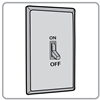 My company currently uses
lower wattage lights at an average of
watts each and
higher wattage lights at an average of
watts. My employees are away from their desks for an average of
hours per day but work
days per week for an average of
hours per week.
My company currently uses
lower wattage lights at an average of
watts each and
higher wattage lights at an average of
watts. My employees are away from their desks for an average of
hours per day but work
days per week for an average of
hours per week. We pledge to encourage our employees to turn off the lights at their desks when they leave the room for lunch and at the end of the day.
- Electricity emission factor (gCO2/kWh): 590
- Electricity price: 0 cents per kWh (your local energy price based on the location you selected in the Introduction tab)
|
|

My company will replace exit signs with efficient LED exit signs which will cost $ each.
- Your company will save 325 kWh/sign
- Price of electricity: 0 (cents/kWh)

|
|
 On average, my company uses the lights about
hours a day. We have
T-12 lights that we will upgrade to T-8 lights.
On average, my company uses the lights about
hours a day. We have
T-12 lights that we will upgrade to T-8 lights.
- Wattage of T-12 lights:
- Wattage of T-8 lights:
- Cost of each new T8 light: $
- Price of electricity: 0 (cents/kWh)

|
|
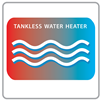
The water heater(s) is/are usually set to degrees fahrenheit and runs on My company will replace our existing waterheater(s) with new natural gas heater(s) that cost $ each.
|
|
 My company uses:
for heating purposes.
Typical 0 square foot businesses in the
0
sector in my climate spend $0 per year on heating. My company uses
of similar businesses to heat the workplace, or $0 per year.
We will turn our thermostat down
degrees F on winter days and
degrees F on winter nights.
My company uses:
for heating purposes.
Typical 0 square foot businesses in the
0
sector in my climate spend $0 per year on heating. My company uses
of similar businesses to heat the workplace, or $0 per year.
We will turn our thermostat down
degrees F on winter days and
degrees F on winter nights.
- Price of electricity: 0 cents/kWh (based on your location)
- Price of natural gas (cents/therm): 0
- Price of fuel oil (cents/gallon):
- Heating Degree Days:
- Number of hours with temperature set for:
- Weekdays during the day:
- Weekdays at night:
- Weekends during the day:
- Weekends at night:
- Consumption Intensity: 0 physical units*1000 / (HDD*sqft/1000)
- Emissions per physical unit of fuel: 0 gCO2e
- Physical units: kWh of electricity; cubic feet of natural gas; gallons of fuel oil
- Annual energy consumption in physical units of selected fuel type: 0
|
|
 Typical 0 square foot businesses in my climate spend $
0 (0 kWh)
per year on air conditioning. My company uses the AC about
of typical businesses, or $0
(0 kWh) per year.
We will turn the thermostat up
degrees F on summer days and
degrees F on summer nights.
Typical 0 square foot businesses in my climate spend $
0 (0 kWh)
per year on air conditioning. My company uses the AC about
of typical businesses, or $0
(0 kWh) per year.
We will turn the thermostat up
degrees F on summer days and
degrees F on summer nights.
- Price of electricity (cents/kWh): 0
- Cooling degree-days:
- Number of hours with temperature set for:
- Weekdays during the day:
- Weekdays at night:
- Weekends during the day:
- Weekends at night:
|
|

A typical 0 square foot business in my climate spends $0 (0 kWh) per year on air conditioning. We use the AC about
of typical businesses, or $0
(0 kWh) per year.
We will replace our conventional air conditioner(s) that have a SEER rating of
with Energy Star air conditioner(s) that have a SEER rating of .
- Price of electricity (cents/kWh): 0
- Cooling degree-days:
- The cost difference between a conventional air conditioner and an energy star air conditioner is dollars
|
|
 I heat my business with:
A typical 0 square foot business in my climate spends $0 per year on heating. I heat my home about
of typical businesses, or $0 per year.
I heat my business with:
A typical 0 square foot business in my climate spends $0 per year on heating. I heat my home about
of typical businesses, or $0 per year.
- Price of electricity: 0 cents/kWh (based on your location)
- Price of natural gas (cents/therm): 0
- Price of fuel oil (cents/gallon):
- Heating Degree Days:
|
|
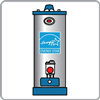
My business will replace conventional water heaters with a new energy efficient (Energy Star) water heater that will cost $ each.
- Water heating intensity: 6.75 kbtu/sq ft
- Natural gas energy by conventional unit:
- The Energy Star units save over conventional models
|
|
 The next time my company purchases a new refrigerator, we pledge to make it an Energy Star qualified decision.
The next time my company purchases a new refrigerator, we pledge to make it an Energy Star qualified decision.
New refrigerator type:
The Energy Star model costs an additional dollars compared to the conventional model.
- Refrigerator fresh volume: cubic feet
- Refrigerator freezer volume: cubic feet
- The total volume is: 0 cubic feet
- Efficiency of conventional model: 0 kWh per cubic feet
- Efficiency of Energy Star model: 0 kWh per cubic feet
- Electricity price: 0 cents per kWh (your local energy price based on the location you selected in the Introduction tab)
|
|

My company will replace conventional printers with Energy Star printers. We will purchase them for $ each.
- Annual energy savings: kWh
|
|

My company will replace conventional copiers with Energy Star copiers. We can purchase them for $ each.
- Annual energy savings: kWh
|
|

My company will replace conventional desktops with Energy Star desktops. We will purchase them for $ each.
- Annual energy savings: kWh
|
|

My company has desktops and monitors.
We will put
of our desktops in sleep or hibernate mode during nights and weekends and turn off
of our monitors during nights and weekends.
- Your business can save 500 kWh or more every year from putting computers in sleep mode
- Your business can save 250 kWh or more every year from putting your monitors in sleep mode
|
|

Our company's monthly battery use:
AAAAA
C
D
9V
We will buy rechargeable batteries instead of disposable ones.
Disposable batteries are alkaline and rechargable batteries are NiCd Rechargeable batteries can be re-used time and costs times as much as disposable models
Cost of disposable batteries:
-
$
per AAA
$ per AA
$ per C
$ per D
$ per 9V
|
|
 My company uses 0 kilowatt hours of electricity per year, which produces
0 metric tons of CO2e per year.
We will purchase
of our electricity from a clean energy provider at a cost of $
per metric ton of CO2e.
My company uses 0 kilowatt hours of electricity per year, which produces
0 metric tons of CO2e per year.
We will purchase
of our electricity from a clean energy provider at a cost of $
per metric ton of CO2e.
- Cost of electricity cents per kWh
- Green Power Facts Source: National Renewable Energy Laboratory Report - Voluntary Green Power Market Forecast through 2015. May 2010 nrel.gov PDF
|
|
 My company uses 0 kilowatt hours of electricity per year, which produces 0 metric tons of CO2e per year.
My company uses 0 kilowatt hours of electricity per year, which produces 0 metric tons of CO2e per year.
We will meet of our electricity needs by installing solar photovoltaic (PV) panels. It costs $ per watt.

|
|

My company will retrocommission of our buildings in order to improve our building's operations and maintenance procedures and enhance overall building performance. It will cost $ per sq ft.
- Through retrocommissioning your workplace, 16% of your natural gas and 16% of your electricity use is saved
- See LBNL's Building Commissioning page for more information
|
|

My company will replace square feet of roof area with cool roofs that will cost $ per square foot.
- Cool roofs can help save electricity use but keep in mind that this usually corresponds with an increase in natural gas use for additional winter heating
- The kWh savings instensity of cool roofs is $402 per kWh/1000 sq ft
- The natural gas savings intensity of cool roofs is -$438 per cubic feet nat gas/1000 sq ft
|
|
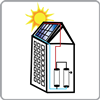 A typical 0 square foot business in my climate uses
$0
per year on heating.
A typical 0 square foot business in my climate uses
$0
per year on heating.
We will meet of our heating needs by installing solar photovoltaic (PV) panels. It costs $ per cubic feet of natural gas.
|
|

On average, we collectively take showers a day.
Our showers are on average taken for minutes each.
Of my company's showerheads, we will replace
of them with more efficient, low-flow showerheads.
They will each cost $.
- The cost to heat a gallon of water using natural gas is $
- We assume that the conventional showerheads use gallons per minute while the new low-flow showerheads use gallons per minute
|
|

On average, we collectively use our faucets times a day.
Of my company's faucets, we will replace
of them with more efficient, low-flow faucets.
They will each cost $.
- On average, we assume that a faucet is used for per use
- We assume that the conventional faucet uses gallons per minute while the new low-flow faucets use gallons per minute
|
|

Our company will replace of our old gallon per flush toilet(s) with a gallon low-flush model that costs $
|
|

A business of 0 square feet typically has . Water efficient
landscapes can be obtained by introducing more drought-tolerant plants to your business' landscape and maintaining them more efficiently with drip-irrigation.
Landscape
The current composition of my business' landscape is:
grass
plants
drought-tolerant plants
We will redo the landscaping so that the new composition of the landscape is:
grass
plants
drought-tolerant plants
Irrigation
Currently,
of our grass and
of our plants are maintained through drip-irrigation.
We will rework our irrigation so that
of our grass and
of our plants are maintained through drip-irrigation.
We assume that the incremental cost of drip irrigation is $ per square foot and the incremental cost of drought-tolerant plants is $ per square foot
|
|

In addition to the direct energy saving benefits, planting trees can increase natural beauty of city landscapes, reduce pollution, cool outside temperatures, as well as provide wood, fruit and other beneficial products.
My company will plant trees. Each tree will cost $
- Each year, you save $10 for every tree planted
- A large portion of your savings come from reduced AC use as a result of increased shading and a reduction in outside temperature. Trees also reduce heating by lowering wind speed
|
|

My company currently throws out cubic yards of trash each week. We will reduce our trash by
- 225 pounds of waste per cubic yard: Source: EPA Warm Model
- 0.58 tCO2 (from methane) per short ton of waste: Source: EPA Warm Model
|
|

My company will print sheets double-sided instead of single-sided per week.
- 14,409 lbs CO2 per ton of paper: Source: Calrecycle
- 0.006 dollars per sheet of paper
|
|
 My business has already pledged to reduce our company's footprint by 0 metric tons of CO2e per year. We will purchase carbon offsets for the remaining 0 tons of CO2e at a cost of
$
dollars per metric ton.
My business has already pledged to reduce our company's footprint by 0 metric tons of CO2e per year. We will purchase carbon offsets for the remaining 0 tons of CO2e at a cost of
$
dollars per metric ton.- Offsets are assumed to be "additional" greenhouse gas emissions that would NOT otherwise be reduced without your purchase of carbon offsets. Examples include projects that would not be profitable, and therefore not undertaken, without the additional funds provided by carbon offset sponsors
|
|
 My business has already pledged to reduce our food, goods and services footprint by 0 metric tons of CO2e per year. We will purchase carbon offsets for the remaining 0 tons of CO2e at a cost of
$
dollars per metric ton.
My business has already pledged to reduce our food, goods and services footprint by 0 metric tons of CO2e per year. We will purchase carbon offsets for the remaining 0 tons of CO2e at a cost of
$
dollars per metric ton. - Offsets are assumed to be "additional" greenhouse gas emissions that would NOT otherwise be reduced without your purchase of carbon offsets. Examples include projects that would not be profitable, and therefore not undertaken, without the additional funds provided by carbon offset sponsors



























